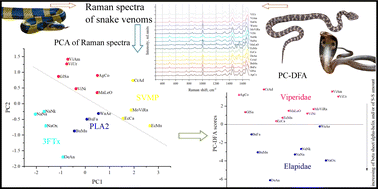Differentiation of snake venom using Raman spectroscopic analysis†
Abstract
Snake venoms are complex mixtures of different substances, proteins being their predominant components. To study the composition of venoms, methods based on chromatographic separation and mass spectrometric analysis are currently used, requiring the application of a number of sophisticated instruments. To assess the composition of snake venoms, we propose an alternative method based on Raman spectroscopy, which is an express method to study the structural features of different substances, including proteins. The method does not require preliminary preparation of the samples, which are used in small quantities; this makes Raman spectroscopy extremely attractive for venom research. In this work, we have carried out Raman spectroscopic studies on a number of dry venoms from various venomous snakes. Based on the obtained Raman spectra, with the help of mathematical methods of dimensionality reduction and clustering, differentiation of venoms reflecting their composition and the assignment of the venom producing snake to the corresponding family or even genus were performed. The proposed method can be used to analyze both the composition of and variations in venoms of different snake species, including rare and endangered ones.

- This article is part of the themed collection: Editor’s Choice: Kaushik Chatterjee


 Please wait while we load your content...
Please wait while we load your content...